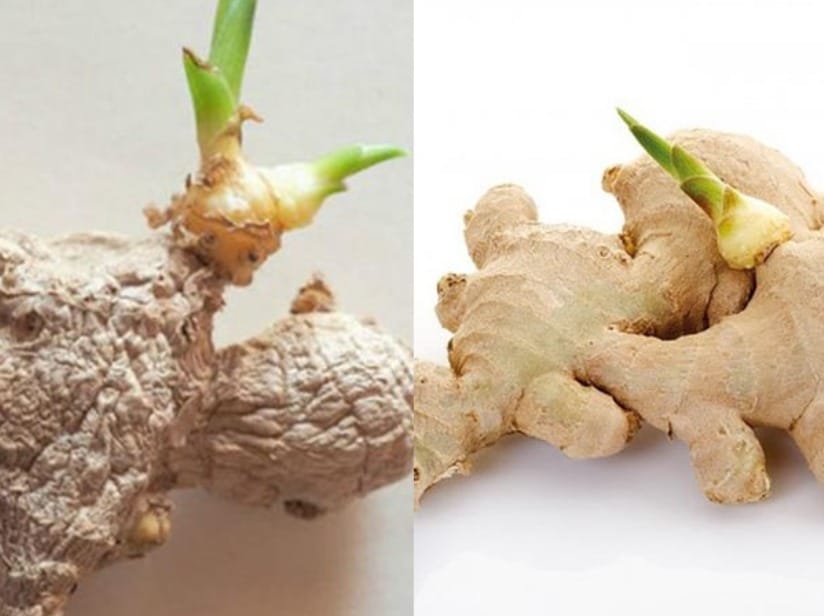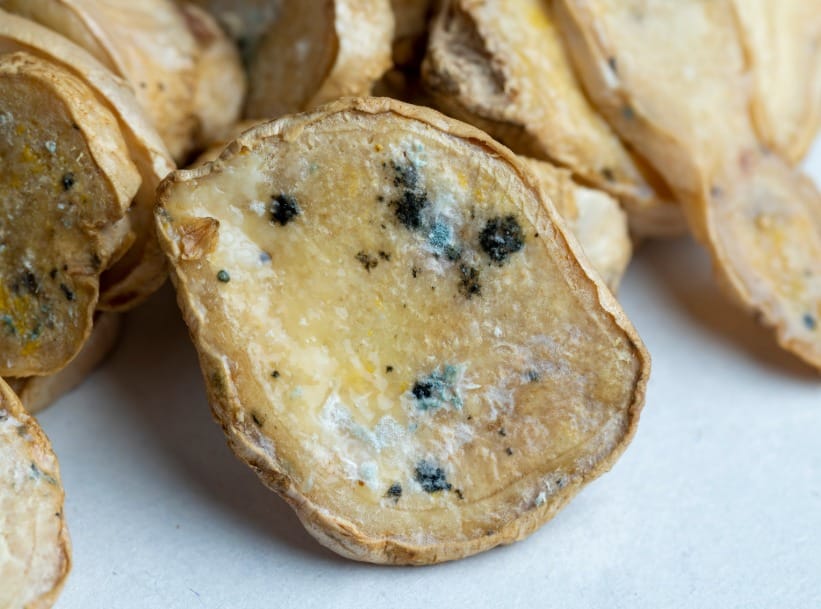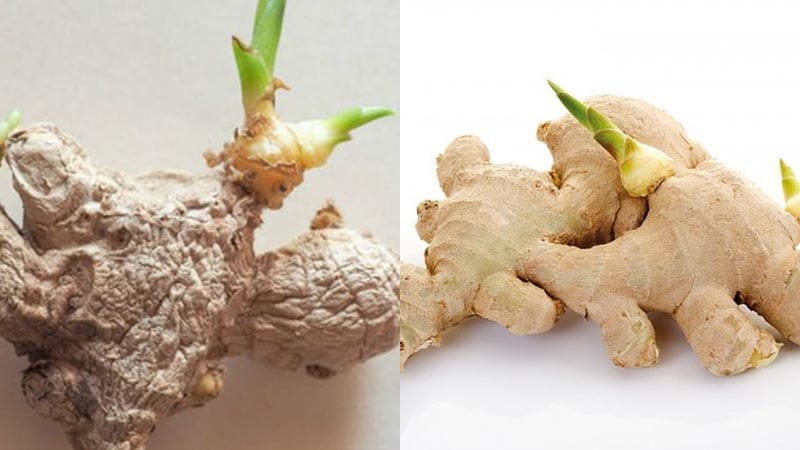Many people wonder “green ginger can be eaten?” when they discover that the ginger in the kitchen has an unusual green color. This phenomenon can appear for many different reasons, from natural to signs of spoilage. To ensure health safety and avoid food waste, understanding the causes and how to handle green ginger is essential for every family.
What is “Green Ginger”?
“Green ginger” is a term used to describe ginger that has a green color appearing on the inner flesh or outer skin. This phenomenon makes many people wonder can green ginger be eaten and is it safe to use.
The green color in ginger can appear due to many different reasons. The first is due to the natural process when ginger is grown in strong sunlight, causing chlorophyll to form and create the green color. This is a completely normal phenomenon and does not cause any harm to health.
The second reason is due to improper storage, causing ginger to oxidize and react with the surrounding environment. When exposed to light and high humidity for a long time, some compounds in ginger can change structure and create a green color.
In addition, excessive use of chemical fertilizers or improper use of pesticides can also cause ginger to have an unusual green color. This is a sign to note and avoid using to ensure health safety.

What is “Green Ginger”?
Can you eat ginger that has turned green?
Question green ginger can be eaten depends on the cause of the green color. If the ginger turns green due to the natural process of chlorophyll, it is completely safe to use. This type of ginger is usually light green, evenly colored, and has no strange smell.
Natural greening of ginger usually occurs on young ginger or ginger grown in good light conditions. When cut, the flesh inside is a uniform light green color, without black spots or mold. This type of ginger retains its characteristic spicy flavor and can be used normally in cooking.
However, if can green ginger be eaten is a question that arises from the discovery that ginger is dark green, uneven in color, accompanied by an unpleasant odor or signs of mold and spoilage, it is best not to use it. This may be a sign that the ginger has been contaminated or spoiled due to improper storage.
To ensure safety, carefully observe the color, taste and texture of ginger before deciding to use it. Good ginger, even though it is naturally green, must still be firm, not soft and retain its characteristic aroma.

Can you eat ginger that has turned green?
See now:
Is ginger poisonous if left for a long time? How to identify and use it safely
When should you avoid green ginger?
There are specific cases where you should absolutely avoid using green ginger.
- First is when ginger has uneven dark blue, green or dark green streaks appear scattered throughout the tuber. This is usually a sign of bacterial or mold growth.
- Second, if the ginger is green accompanied by a sour, rancid or strange smell different from the natural smell of ginger, this is a clear sign that the ginger has gone bad. The unusual smell usually appears due to the decomposition of organic matter in ginger.
- Ginger has a structure soft, wet or oozing should also be discarded immediately. This indicates that the cellular structure of the ginger has been destroyed and is no longer safe to use.
- Special attention should be paid to ginger green with black or white spots or mold outside. This is a clear sign of fungal infection, which can produce toxins that are harmful to health.
In addition, children, pregnant women and people with weak immune systems should be more cautious and avoid using ginger with any unusual signs of color to ensure absolute safety.
How to distinguishNatural green ginger vs spoiled green ginger
Distinguishing between natural green ginger and spoiled green ginger is an important skill to help ensure food safety. Natural green ginger is usually light green, evenly colored over the entire cut surface, without strange streaks or spots.
Natural green ginger still retains its characteristic firmness, when pressed it does not sink or leave a dent. The smell of natural green ginger is still the familiar spicy smell, maybe a little lighter but does not have a strange or unpleasant smell.
In contrast, rotten green ginger is often an uneven dark green color, appearing in patches or streaks. When cut, areas of different colors can be seen: dark green, yellow, brown or black. This indicates that the decomposition process has begun.
Structurally, spoiled ginger is often softer than normal, may be mushy or feel wet to the touch. In some cases, green or brown fluid may be seen oozing from the cuts.
Taste is the most important distinguishing feature. Spoiled ginger has a sour, rancid or fermented smell that is completely different from its natural smell. When tasted, the characteristic spicy taste will be replaced by an unpleasant sour or bitter taste.

How to distinguish natural green ginger vs spoiled green ginger
See now:
5 Benefits of Ginger: Natural Remedies Not to Be Missed
How to store ginger to prevent discoloration
To prevent ginger from turning green and prolonging its shelf life, proper storage is extremely important. First, choose fresh, delicious ginger with a shiny outer skin, without scratches or signs of spoilage.
After purchasing, do not wash ginger immediately if not used. Excess moisture will create conditions for bacteria to grow. Instead, wipe off dirt with a dry towel and store in a cool, dry place.
For whole ginger, it is best to wrap it in newspaper or paper towels and then place it in the refrigerator. The paper will absorb excess moisture and keep the ginger dry. Avoid using sealed plastic bags as this creates a humid environment that is conducive to mold growth.
If you have cut ginger, cover the cut part with plastic wrap or foil to avoid exposure to air. Cut ginger should be used within 1-2 weeks to ensure the best quality.
With peeled ginger, you can store it in a sealed container in the refrigerator or soak it in white wine to extend its shelf life. The wine soaking method not only preserves but also adds a special flavor to the ginger.
Viot Minh Trang – Reliable supplier of export quality ginger
When learning about green ginger can be eaten choosing a quality ginger source from the beginning is the most important thing. Viot Minh Trang is proud to be a leading enterprise in the field of producing and exporting high quality ginger, meeting strict international standards.
With a wide system of linked growing areas greater than 3,000 hectaresStretching from Nghe An, Thanh Hoa, Hoa Binh, Son La to Dak Lak, Viot Minh Trang strictly controls the entire process from seed to harvest. The farming model follows clean standards, towards organic, without using toxic chemicals to ensure ginger products are always safe and of high quality.
Viot’s processing plant achieves certifications ISO 22000, HACCP, GMP, Halal with modern, closed chain. This ensures that ginger is processed and preserved in optimal conditions, minimizing the risk of bacterial contamination or deterioration that causes abnormal green color.

Viot Minh Trang – Reliable supplier of export ginger
Viot Minh Trang ginger products are not only popular in the domestic market but also successfully exported to demanding markets such as Japan, the EU, and the United States. This proves the superior quality and high safety of the product.
With the motto “quality is honor – trust is the foundation – creativity is the driving force – sustainable development is the long-term goal”, Viot Minh Trang commits to providing fresh, delicious and safe ginger, helping consumers feel completely secure when using it without having to worry about the problem can green ginger be eaten?.
Choosing ginger from Viot Minh Trang means you are choosing a product with quality control from cultivation to processing, ensuring there are no problems with unusual color or substandard quality.





Tác giả Tưởng Mạnh Biên
Là chuyên gia giàu kinh nghiệm trong lĩnh vực xuất khẩu nông sản. Với nhiều năm làm việc, nghiên cứu và trực tiếp tham gia vào các hoạt động sản xuất, kinh doanh và xuất khẩu nông sản, tác giả chia sẻ những kiến thức chuyên môn sâu sắc cùng các bài học thực tiễn giá trị nhằm hỗ trợ doanh nghiệp.
- Địa chỉ: Số 27, Tổ 23, Lĩnh Nam, Hoàng Mai, Hà Nội
- Email: viotvietnam.vn@gmail.com
- SĐT: 0977 728 269